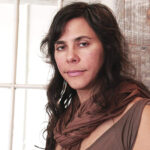Kim Thuy’s fourth novel continues the author’s style of recalling her own journey to Canada and crossing linguistic and cultural boundaries.
“I don’t mind at all being considered as migrant literature, Asian literature, Canadian literature, or Quebec literature,” says the award-winning author, who just published Vi. “It depends on the person who’s reading it and what the person sees in it.”
Vi tells the story of a woman, Vi, who returns to Vietnam after growing up in Canada. Vi is on a journey to discover the vastness of life, or ‘vie‘ in French. At the same time, in Vietnamese, vi means microscopically small.
“Like we say in Vietnamese, [with] every single step that we make, we come back with a basket of knowledge,” says Thuy. “To me, Vi is about learning to become a person, to become a human.”
Although “the family situation of Vi is not me, the vision of Vi is a lot like I see life,” says Thuy. The character Vi studies translation and then law, much like Thuy who has reinvented herself throughout her life – first as an interpreter, then a lawyer and restaurateur, and now an author.
“To me, Vi is about learning to become a person, to become a human.”
Life provides a springboard
In her 2009 novel, Ru, the author traces a young woman’s trek from her home in Saigon, Vietnam, during the Vietnam War, to a Malaysian refugee camp, and then to Quebec where she struggles to adapt. With a plot line based on her own life chronology, Thuy writes what she knows. She says this is the only writing process that works for her.
”I stick with women . . . because I think women are so extraordinary and many of us are misunderstood or underestimated,” says Thuy. “Vietnamese women are often considered submissive or obedient or kind and attentive,” she adds. “I wanted to show that . . . social codes sometimes mislead our interpretation of the person.”
Thuy says paintings of Japanese, Chinese and Vietnamese women portrayed, “with a little tiny dot of red for the mouth,” act as a cultural metaphor.
“Women are not supposed to speak if they want to be elegant and dignified women . . . so that’s why they are very often misunderstood.“
A story that resonates
In many ways, Thuy speaks for those unable to tell their own stories.
“She was one of the boat people,” says Jenny Lam, referring to her mother and the Vietnamese refugees who fled to Canada after the Vietnam War. Lam says that while literature is not her thing, she does read Kim Thuy and even attended a recent launch for Vi featuring Thuy in Montreal.
Thuy says paintings of Japanese, Chinese, and Vietnamese women portrayed, “with a little tiny dot of red for the mouth,” act as a cultural metaphor.
Reading Thuy’s novels is like reading her mom’s story, she says.
Sabrina Cordy says she also seeks to feel connected through Thuy’s “spontaneous” writing. Adopted by Belgian parents, the 24-year-old of Korean descent now lives in Montreal and says Thuy’s writing “reminds me of my culture.”
Thuy says she is “touched” that so many Asian Canadians read her novels and attended the launch of Vi, and notes that many of them are young women.
“Most parents don’t talk about their experiences,” she says. She adds that Ru “triggered a conversation between the parents and the children about that episode in their life.”
Accessing immigrants’ stories
A best seller in Quebec and in France, her first novel, Ru, has sold more than 235,000 copies abroad and has been translated in 25 languages.
The popularity of her books is partly due to their poetic and accessible style, or what Francois Godin of Quebec publisher Libre Expression calls her ability to “create literary bridges.”
“Thuy’s books are educational about the immigration story.”
“I like the images, the simplicity, the human element of her writing,” says Catherine Emond, who has read all of Thuy’s books, adding that as a “dyed-in-the-wool Quebecois [a Quebecer of French Canadian descent], Thuy’s books are educational about the immigration story.”
In 2015, the English translation of Ru won CBC Canada Reads as the Book to Break All Barriers thanks to Cameron Bailey, Artistic Director of the Toronto International Film Festival, who championed the book.
“A lot of Canadians have grown tired of being nice to newcomers. That’s the barrier that we’re trying to break and Ru reminded me why migrants matter,” Bailey said in 2015.
“Ru did that with a deep and moving beauty. It’s a hopeful book. It invites compassion and draws a wide circle of readers in.”
Reflecting on the competition, Thuy says she is happy she won, but wasn’t out to break barriers when she wrote Ru.
“When we arrived here, people welcomed us with open arms . . . And if I wrote Ru, it was to thank all these people who have given me access to everything,” says Thuy. “In Ru, it’s about how life is perfect after all, even though it is hard and there are so many challenges, it is still perfect in the end.”
Thuy says life is beautiful because it is difficult.
“You cannot have one without the other,” she says. “You cannot appreciate white without knowing black.”
Elvira Truglia is a Montreal-based journalist who writes about the intersections of culture, politics, and social issues. She has also worked in the community, media and cultural sector as well as national and international non-governmental organizations.





